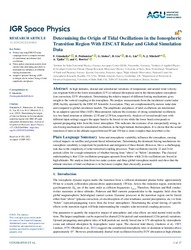Determining the Origin of Tidal Oscillations in the Ionospheric Transition Region With EISCAT Radar and Global Simulation Data
DOI: https://doi.org/10.1029/2022JA030861
Persistent URL: http://resolver.sub.uni-goettingen.de/purl?gldocs-11858/10460
Persistent URL: http://resolver.sub.uni-goettingen.de/purl?gldocs-11858/10460
Günzkofer, F.; Pokhotelov, D.; Stober, G.; Liu, H.; Liu, H.‐L.; Mitchell, N. J.; Tjulin, A.; Borries, C., 2022: Determining the Origin of Tidal Oscillations in the Ionospheric Transition Region With EISCAT Radar and Global Simulation Data. In: Journal of Geophysical Research: Space Physics, Band 127, 10, DOI: 10.1029/2022JA030861.
 |
Dokument öffnen: |
At high‐latitudes, diurnal and semidiurnal variations of temperature and neutral wind velocity can originate both in the lower atmosphere (UV or infrared absorption) and in the thermosphere‐ionosphere (ion convection, EUV absorption). Determining the relative impact of different forcing mechanisms gives insight to the vertical coupling in the ionosphere. We analyze measurements from the incoherent scatter radar (ISR) facility operated by the EISCAT Scientific Association. They are complemented by meteor radar data and compared to global circulation models. The amplitudes and phases of tidal oscillations are determined by an adaptive spectral filter (ASF). Measurements indicate the existence of strong semidiurnal oscillations in a two‐band structure at altitudes ≲110 and ≳130 km, respectively. Analysis of several model runs with different input settings suggest the upper band to be forced in situ while the lower band corresponds to upward‐propagating tides from the lower atmosphere. This indicates the existence of an unexpectedly strong, in situ forcing mechanism for semidiurnal oscillations in the high‐latitude thermosphere. It is shown that the actual transition of tides in the altitude region between 90 and 150 km is more complex than described so far. Plain Language Summary:
Solar and atmospheric variability influence the ionosphere, causing critical impacts on satellite and ground‐based infrastructure. Determining the dominant forcing mechanisms for ionosphere variability is important for prediction and mitigation of these threats. However, this is a challenging task due to the complexity of solar‐terrestrial coupling processes. Tidal oscillations (mostly 12 and 24‐hr periods) allow for a rough estimations of whether forcing from “above” or “below” dominates. The classical understanding is that 12‐hr oscillations propagate upwards from below while 24‐hr oscillations are forced at high altitudes. We analyze data from two radar systems and three global ionosphere models and show that the altitude structure of tidal oscillations is in fact more complex than classically assumed. Key Points:
Twenty‐day long EISCAT radar campaign shows a complex mixture of semidiurnal and diurnal tidal oscillations.
Three global circulation models show similar tidal structuring and allow to determine the influence of different forcing mechanisms.
Adaptive spectral filtering (ASF) technique allows robust fitting of tidal amplitudes and phases.
Statistik:
ZugriffsstatistikSammlung:
This is an open access article under the terms of the Creative Commons Attribution License, which permits use, distribution and reproduction in any medium, provided the original work is properly cited.

